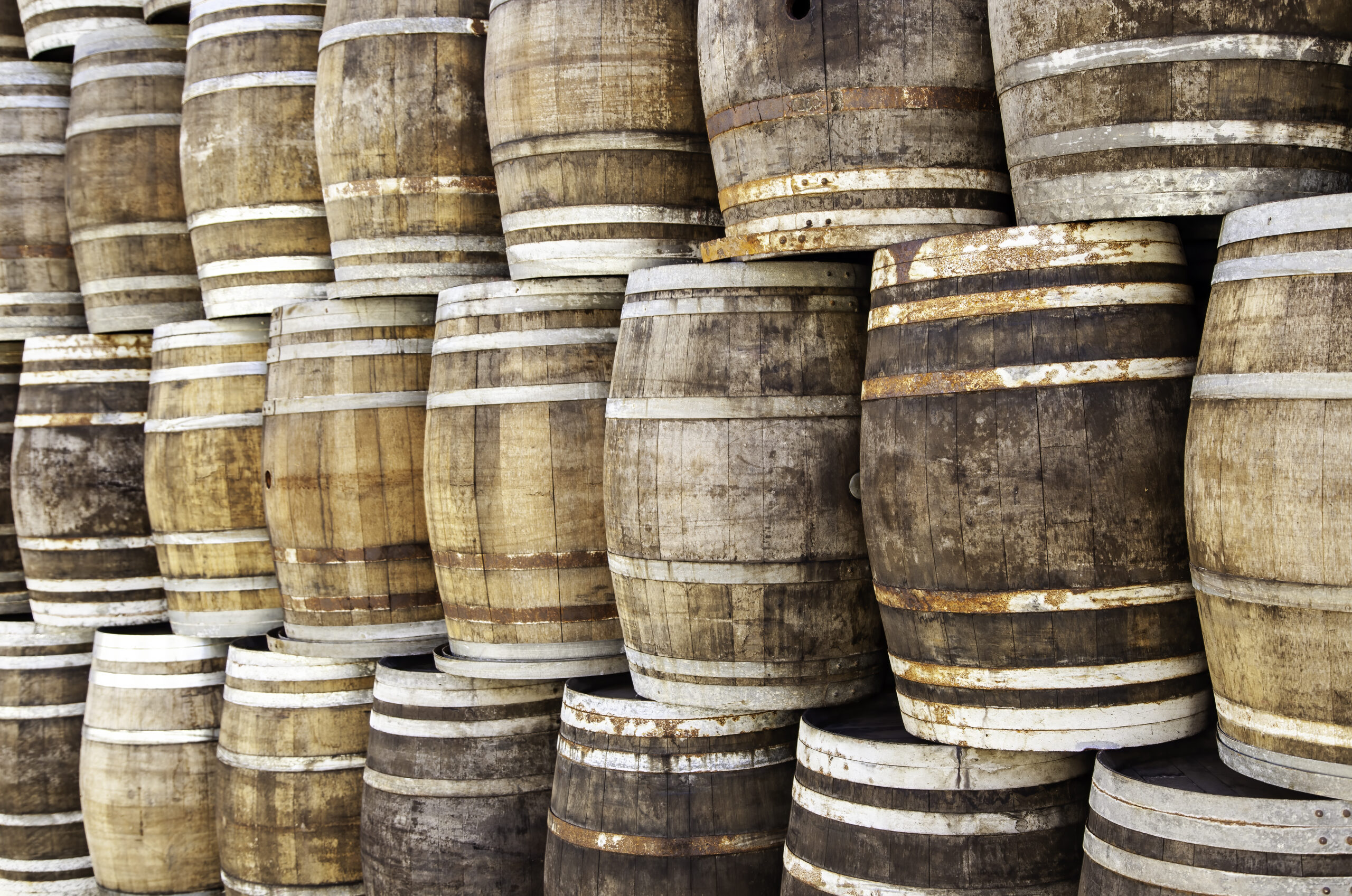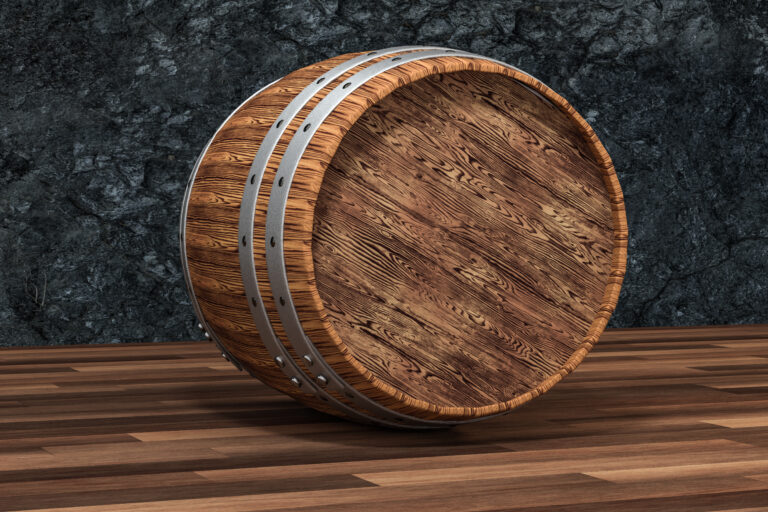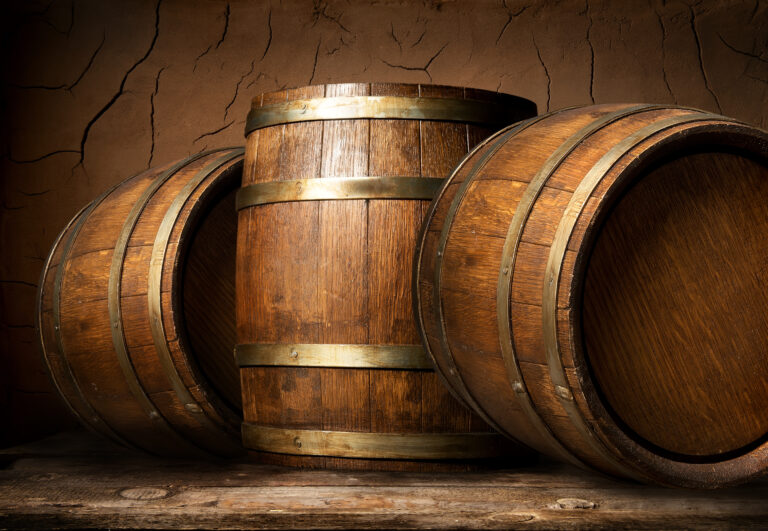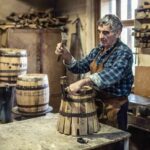Ever wonder what gives whiskey that signature oaky and smoky character? It all boils down to barrel aging, a time-honored process. For centuries, distillers have matured their whiskey in charred oak barrels, a crucial step that imparts those distinctive flavors and rich color.
Barrel aging whiskey is truly an art, a beautiful marriage of tradition and innovation. Master distillers carefully select high-quality oak barrels, often crafted from American white oak. They then meticulously char the inside of these barrels before filling them with freshly distilled spirits. As the whiskey patiently rests, it gradually extracts a symphony of flavors and enticing aromas from the wood. The charred oak barrel generously contributes notes of sweet vanilla, luscious caramel, and warm toasted nuts.
While time-honored methods remain central, a wave of distillers are embracing experimentation with diverse barrel variations. They’re venturing into using barrels that once cradled rich port, elegant sherry, vibrant rum, or zesty tequila. Some are even tailoring the char levels of their barrels to achieve specific nuances. Others are sourcing unique oak from regions like France, Spain, and Japan, aiming to unlock entirely new and captivating flavor profiles in their whiskies.
Barrel aging will undoubtedly remain an indispensable element in crafting exceptional whiskey. Yet, as distillers artfully blend tradition with boundless creativity, there’s never been a more exhilarating era to be a whiskey lover. Each sip whispers a story, and countless more intriguing tales are waiting to be unveiled.
The History of Barrel Toasting in Whiskey Making
The tradition of barrel toasting in whiskey making stretches back through the annals of time. Distillers of old would gently char the interior of oak barrels before entrusting them with their whiskey, a practice that subtly infused smoky undertones and beautiful amber hues. Today, a new generation of distillers are boldly experimenting with a spectrum of toasting levels and diverse barrel types, injecting modern twists into this revered technique.
The Light Toast
A light toast involves a brief and gentle charring of the barrel, resulting in delicate smoky nuances. The whiskey gracefully absorbs subtle oak flavors, such as the sweet embrace of vanilla, the rich warmth of caramel, and a gentle hint of spice. Popular for bourbon and rye, a light toast allows the inherent character of the grain to truly shine through.
The Medium Toast
A medium toast involves a more substantial charring, coaxing out more pronounced oak flavors. The whiskey develops richer notes of comforting toasted nuts, decadent cocoa, and succulent dried fruit. Frequently employed for both bourbon and single malts, a medium toast strikes a harmonious balance between smoky depth, oak influence, and the fundamental character of the base spirit.
The Heavy Toast
A heavy toast subjects the barrel to significant charring, yielding bold and assertive smoky and oak flavors. The whiskey takes on intriguing tastes of intense espresso, deep molasses, and luxurious dark chocolate. Often favored for single malts, a heavy toast can be quite dominant and might overshadow more delicate whiskies.
Alternative Barrels
Pushing beyond tradition, some distillers are exploring barrels crafted from woods like maple, cherry, and apple. These unconventional choices impart distinctive sweet and fruity notes to the whiskey. Furthermore, port, sherry, and wine casks are gaining popularity, contributing complex notes of ripe berries, sweet raisins, and juicy plums.
Whether adhering to time-honored practices or boldly charting new territory, barrel toasting empowers distillers and blenders to sculpt a whiskey’s unique flavor and captivating aroma. By artfully manipulating toasting levels and embracing alternative barrels, modern whiskey makers possess an expanded palette to create truly exceptional tasting experiences. The age-old practice of barrel toasting continues its exciting evolution.
Why Barrels Are Toasted in Whiskey Production
Toasting barrels stands as an essential step in the intricate process of producing whiskey. The inner surfaces of the barrels undergo charring, a crucial treatment that helps to impart both flavor and distinct character to the spirit as it gracefully matures.
The process of barrel toasting expertly prepares the wood, gently opening up its pores and meticulously breaking down the complex cellulose structures within. This crucial transformation allows the whiskey to penetrate deeply into the wood, diligently extracting aromatic compounds, notably vanillin, alongside beneficial organic acids that contribute delightful tangy and fruity notes.
The precise level of toasting and charring can be meticulously customized, tailored to the distiller’s specific vision and desired outcome. Lightly toasted barrels might only be kissed by the flames for a fleeting few seconds, imparting subtle hints of spice and delicate smokiness. Conversely, a medium toast exposes the barrel to higher heat for a duration of 30 to 45 seconds, resulting in more pronounced notes of sweet vanilla and rich caramel. A heavy char creates an almost intentionally burnt, ashy layer that can ultimately lead to intriguing flavors of dark chocolate, roasted coffee, and the deep sweetness of darker stone fruits in the finished whiskey.
Some discerning distillers artfully employ a harmonious combination of light, medium, and heavy toasts to orchestrate a complex and multi-dimensional spirit. Others might explore the use of barrels crafted from diverse wood types, such as classic American oak, elegant French oak, or the rich influence of sherry casks, all to weave an intricate tapestry of flavors within a single bottle.
Modern distillers are also enthusiastically experimenting with innovative barrel finishes – a secondary maturation where the whiskey is transferred to a different barrel that previously held treasures like port, rum, or wine. This final flourish can introduce captivating fruity, nutty, or spicy notes that beautifully complement the traditional oak barrel flavors.
Whether steadfastly honoring tradition or boldly venturing into uncharted territory, barrel toasting remains both a meticulous craft and a refined art form, empowering distillers to create an endless array of distinctive whiskies. The remarkable results are undoubtedly worthy of raising a glass in appreciative toast.
Traditional Methods of Barrel Toasting
The traditional method of barrel toasting involves the time-honored practice of charring the inside of barrels over an open flame. Cooperages and distilleries have relied on this fundamental technique for centuries to imbue aged spirits like whiskey, brandy, and rum with their characteristic flavors and captivating aromas.
Charring Barrels
Barrels are expertly toasted by carefully rolling and rotating them over an open fire, often fueled by wood chips, fragrant shavings, or precisely controlled gas burners. As the barrels gracefully spin, the fire gently chars their interior, skillfully caramelizing the natural wood sugars. The specific level of char is meticulously determined by the distiller’s desired flavor profile. Lightly toasted barrels, exhibiting more subtle charring, are frequently chosen for lighter, fruitier spirits. In contrast, heavier charring, sometimes referred to as charring to the “red layer” due to its distinctive reddish hue, yields more pronounced smoky and spicy notes.
The Result
The interaction between the charred wood and the spirit during the aging process is what imparts those sought-after notes of sweet vanilla, rich caramel, and intriguing smokiness. Furthermore, charred barrels facilitate a gentle exchange of oxygen with the spirit, contributing to a smoother, more mellow flavor. Distillers possess the ability to fine-tune the toasting level, allowing them to precisely craft a specific flavor for their cherished aged spirit. The enduring tradition of barrel toasting has persisted because it is fundamentally essential for creating rich, multi-dimensional whiskey and other esteemed aged spirits.
While these time-honored methods remain prevalent, some forward-thinking modern distillers are exploring innovative barrel toasting techniques to unlock entirely new and exciting flavors. While flame-charring and wood-fire toasting retain their popularity, novel approaches such as convection toasting, steam bending staves, and aging in barrels with custom wood inserts are introducing unique and captivating flavors. Though unconventional, these modern techniques empower creative distillers to push the boundaries of flavor in aged spirits. The tradition of barrel toasting not only endures but continues to evolve in fascinating new directions.
Modern Innovations in Barrel Toasting
Cooperages today are at the forefront of experimentation, exploring diverse wood types, nuanced toast levels, and cutting-edge techniques to craft innovative flavors in whiskey.
Some distilleries are venturing beyond the traditional American white oak, embracing barrels crafted from woods like elegant French oak, distinctive Hungarian oak, or the exotic Japanese mizunara oak. These alternative woods can impart truly unique flavor notes to the whiskey. For instance, French oak may contribute delicate hints of warm cinnamon and aromatic clove, while mizunara oak can introduce intriguing tropical flavors reminiscent of creamy coconut or fragrant sandalwood.
While medium toast or medium char barrels are commonly employed for aging bourbon, some distilleries are pushing the boundaries with heavy toast or even intensely charred “alligator” char barrels to achieve bolder, smokier flavors. The longer a barrel is toasted, the darker its interior becomes, and the more robust the flavor it can ultimately impart.
Certain coopers are also experimenting with the technique of grooving or scoring the inside of barrels, a process designed to increase the surface area of wood that comes into contact with the whiskey. This innovative approach can potentially accelerate the aging process and contribute to the development of more complex flavors.
The practice of “finishing” whiskey in used barrels that previously held fortified wines, brandies, or other spirits has emerged as a popular method for creating truly unique flavor profiles. Port, sherry, rum, or even tequila barrels are frequently employed for finishing both bourbon and rye whiskies.
Furthermore, some are exploring the use of heating elements inserted directly into barrels as a means to expedite maturation and encourage the formation of specific flavor compounds. While this technique remains somewhat controversial, it has the potential to produce distinctive tastes in a shorter timeframe.
The tradition of barrel toasting within the whiskey industry is in a constant state of evolution, driven by relentless experimentation and innovation. While time-honored methods certainly retain their significance, modern cooperages are embracing new woods, diverse toasts, and novel techniques to craft custom barrels and finish whiskies with unprecedented flavors. The exciting result is a captivating array of distinctive and flavorful craft whiskies for discerning aficionados to explore and thoroughly enjoy.
Unique Barrel Finishes Through Creative Toasting
Distilleries are increasingly embracing creative barrel finishes as a means to produce truly unique flavor profiles in their cherished whiskies. Once the standard aging period in charred oak barrels reaches its conclusion, the whiskey is carefully transferred to a second barrel that previously housed another esteemed spirit or fine wine. This secondary maturation subtly infuses the whiskey with intriguing flavor notes gleaned from the previous contents of the wood.
Port Barrels
A particularly popular barrel finish involves aging whiskey in used port wine casks. The port-soaked wood generously infuses the whiskey with delightful hints of dried fruit, such as sweet raisins, alongside luscious flavors of rich chocolate and smooth caramel. The whiskey often takes on a beautiful ruby tint, a visual testament to its time spent in the port barrels. Esteemed distilleries like Westland and Cedar Ridge have embraced port barrels to impart distinctive finishes to their exceptional single malts.
Rum Barrels
For a captivating tropical twist, some distilleries opt to finish their whiskey in rum barrels. These rum barrels contribute enticing hints of warm molasses, sweet brown sugar, and vibrant tropical fruit. The whiskey often picks up a subtle, underlying rum-like sweetness. Few Spirits in Illinois has gained recognition for its bourbon finished in rum barrels, while several innovative Scottish distilleries also employ rum barrels for their distinguished single malts.
Sherry Barrels
Whiskey aged in sherry casks gracefully absorbs the rich flavors of succulent dried fruit, such as sweet apricots, chewy dates, and plump prunes. Intriguing nutty and savory notes, reminiscent of toasted almonds or earthy walnuts, also emerge. The sherry wood imparts a beautiful amber hue to the whiskey. Many renowned single malt Scotch whiskies utilize sherry cask finishing, including esteemed names like Macallan and Glenfarclas. Some forward-thinking American craft distilleries, such as Westward Whiskey, are also exploring the unique influence of sherry barrels.
Cabernet Barrels
For a bold and full-bodied flavor experience, distilleries are finishing their whiskey in used Cabernet Sauvignon wine barrels. This imparts intriguing notes of dark black currant, subtle bell pepper, nuanced tobacco, and rich chocolate. The tannins present in the oak gently soften, and the whiskey often develops a beautiful crimson tint. Both Few Spirits in Illinois and Westward Whiskey in Oregon offer compelling bourbons finished in Cabernet barrels.
Creative barrel finishing empowers distilleries to craft truly unique and complex flavor profiles in their whiskies. By thoughtfully pairing the right barrel with the right spirit, innovative distillers are producing distinctive and truly memorable tasting experiences for passionate whiskey lovers. The possibilities for barrel experimentation appear to be virtually endless!
How Barrel Toasting Impacts Whiskey Flavor
Toasting barrels—or the process of carefully charring their interiors—is an absolutely crucial step in the art of whiskey making. As the barrels are gently heated, the intricate wood structure undergoes a transformation, and its inherent sugars are beautifully caramelized. This barrel char is what imparts a distinctive and complex flavor and captivating aroma to the maturing whiskey. The precise level of char can vary significantly, ranging from a light “toast” to an intense “alligator” char, all depending on the specific duration for which the barrel is toasted.
Light Toast
A brief toast lasting just a minute or two will gently char the wood, coaxing out more subtle and delicate flavors such as sweet vanilla, nutty almond, and creamy coconut. Whiskies aged in lightly toasted barrels tend to exhibit a smoother and often sweeter character. Many classic American bourbons are aged in new charred oak barrels that have undergone a light to medium toast.
Medium Toast
A toasting period of approximately 3 to 5 minutes will result in a medium char level. This process typically yields richer flavors reminiscent of warm honey, aromatic spice, and fragrant nutmeg. Canadian whiskies and certain rye whiskies frequently benefit from aging in medium-toast barrels.
Heavy Toast
Barrels that undergo an “alligator” char, or a heavy toast lasting over 5 minutes, will impart more robust and intense flavors to the whiskey, such as deep molasses, rich cocoa, and roasted coffee. These full-bodied and smoky characteristics are often found in distinguished single malt Scotch whiskies.
Modern Twists
Some forward-thinking distillers are actively experimenting with different wood varieties, varying toast levels, and innovative aging techniques to craft truly unique flavor profiles in their whiskies. Hickory, cherry, maple, and applewood barrels are being explored by some adventurous craft distilleries. The technique of double barreling, where whiskey is initially aged in one barrel and then finished in a second, allows distinct flavors from two different wood types to harmoniously meld. Furthermore, heavily toasted or even intentionally burnt barrels can create an intensely smoky effect, sometimes described as “whiskey on steroids.”
Whether adhering to cherished traditions or boldly forging new paths, barrel toasting remains a fundamental key to developing the distinctive flavor of whiskey. By artfully manipulating this single yet crucial step, distillers possess an infinite palette from which to create memorable and complex whiskies.
Notable Whiskey Brands Using Innovative Toasting Techniques
Several whiskey brands are putting their own innovative spins on the traditional barrel toasting process. These unique techniques result in notable and distinctive flavor profiles in the finished spirit.
Maker’s Mark
Maker’s Mark is renowned for its exceptionally smooth and subtly sweet bourbon. They achieve this signature character through a proprietary “wood stave insertion” method. After the barrels undergo toasting, they carefully insert wooden staves of varying char levels into the barrels. As the whiskey patiently ages, it diligently extracts complex flavor compounds from these staves. This unique approach helps to create intricate layers of flavor that are not typically found in traditionally charred barrels.
Templeton Rye
Templeton Rye employs a distinctive “double barrel” technique in its production. Their rye whiskey is initially aged for several years in charred oak barrels. Following this primary maturation, the whiskey undergoes a finishing period in barrels that previously held either port or rum. This secondary aging in “wet” barrels beautifully infuses the whiskey with delightful notes of ripe cherry, warm spice, and sweet vanilla. The double barrel technique ultimately results in a rye whiskey that boasts a sweeter and more complex flavor profile compared to many traditional ryes.
Westland Distillery
Westland Distillery, located in Seattle, employs a diverse range of barrels in the creation of their exceptional “single malt” American whiskey. Some of their barrels undergo longer toasting periods to coax out richer notes of deep molasses and sweet toffee. Conversely, other barrels receive a lighter toast to emphasize the inherent and nuanced grain flavors. By artfully blending whiskey from these various barrels, Westland crafts a captivating flavor profile that harmoniously combines both robust, sweet notes and lighter, more cereal-forward tones. This innovative approach beautifully showcases how barrel toasting can be skillfully employed to create a spectrum of delightful flavors in the final spirit.
St. George Spirits
St. George Spirits, well-regarded for their flavor-forward gins and brandies, also utilizes used barrels to age some of their distinctive whiskies. For their acclaimed Lot 15 Single Malt, they opt for a finishing period in barrels that previously held fortified wine. These barrels impart intriguing fruity and nutty sherry-like flavors to the whiskey. Their Baller Single Malt undergoes a secondary maturation in barrels that once held their own coffee liqueur, resulting in a truly unique whiskey redolent with enticing mocha and warm spice notes. By creatively re-using barrels, St. George Spirits not only finds an eco-conscious approach but also crafts whiskies with remarkable layers of flavor.
Comparing Tradition vs. Modern Barrel Toasting Methods
The tradition of aging whiskey in charred oak barrels has stood the test of time, imparting both distinctive flavor and appealing color to the beloved spirit. However, in today’s dynamic landscape, some forward-thinking distillers are actively experimenting with alternative barrel toasting methods to unlock entirely new and captivating flavors.
Traditional Barrel Toasting
For generations, distillers have relied on the time-honored technique of open-fire barrel toasting. This method involves carefully exposing the inside of barrels to an open flame, a process that skillfully chars the wood. This charring caramelizes the natural sugars within the oak, subsequently adding delightful notes of sweet vanilla and rich caramel to the whiskey as it gracefully ages. The specific level of char, often referred to as the “toast,” significantly influences the resulting flavor. Lighter toasts tend to yield more subtle flavors, while heavier chars contribute more robust and smoky undertones.
Modern Barrel Alternatives
A new wave of innovative distillers are boldly testing alternative barrel toasting techniques with the aim of creating truly distinctive flavors.
- Flash toasting involves rapidly heating barrels to high temperatures for a brief period. This quick heating process can create different flavor compounds compared to traditional charring. The result often includes more pronounced fruity and floral notes, with a less intense smokiness. Several adventurous craft distilleries are employing flash-toasted barrels for finishing aging and adding intriguing complexity to their whiskies.
- Steam toasting utilizes hot steam instead of direct fire to gently heat the barrels. This method tends to produce lighter and sweeter notes, often reminiscent of creamy butterscotch or exotic coconut, without the dominant charred flavors. It’s believed that the lower heat helps to preserve more of the oak’s natural and delicate compounds.
- Groove cutting involves precisely cutting grooves into the staves of the barrel. This technique increases the overall surface area of the wood that comes into contact with the whiskey. The enhanced wood contact can potentially accelerate the aging process and impart oak flavors in a shorter timeframe. Some distillers are exploring the use of groove cutting in conjunction with traditional charring methods.
While the tradition of barrel toasting still holds a place of prominence for most distillers, these modern innovations open up exciting avenues for further experimentation and an expanded range of potential flavors. By thoughtfully combining these new barrel treatments with time-honored methods, distillers can craft whiskies with truly distinctive aromas and captivating taste profiles, designed to satisfy even the most discerning palate. The future of barrel aging certainly looks promising!
The Tradition of Toasting Whiskey Barrels and Its Modern Adaptations
The tradition of aging whiskey in charred oak barrels boasts a rich history spanning centuries. These barrels play a vital role in imparting both characteristic flavor and appealing color to the spirit as it patiently matures. In recent times, modern distillers have embarked on exciting experiments, exploring different wood types and varying barrel sizes to unlock entirely new and unique flavor profiles.
Oak Alternatives
Some adventurous distillers are venturing beyond traditional oak, aging their whiskey in barrels crafted from woods such as robust hickory, sweet maple, or smoky mesquite. These alternative woods contribute distinct flavors that are simply not found in traditional oak. For instance, whiskey aged in mesquite may exhibit intriguing notes of smoke, warm spice, and rich cocoa. Maple-aged whiskey often takes on delightful flavors of sweet vanilla and luscious caramel.
Small Barrels
Aging whiskey in smaller barrels strategically increases the surface area to volume ratio, allowing the spirit to interact more intensely with the wood. This enhanced interaction can significantly speed up the aging process and lead to a more rapid infusion of flavor. Whiskey aged in small barrels, often ranging in size from 5 to 10 gallons, may reach its peak in just 6 to 12 months, rather than the typical years. The resulting whiskey often exhibits an oak-forward and robust flavor profile.
Toasting Levels
The “toast” level refers to the degree to which the inside of the barrel has been charred. A lighter toast, such as a #1 or #2 char, will generally yield a whiskey with more pronounced raw wood and spicy notes. Conversely, a heavier #4 char, sometimes referred to as “alligator char” due to its cracked appearance, will impart richer notes of sweet vanilla, decadent caramel, and smoky undertones, all thanks to the barrel’s darker and more intensely charred interior. Some discerning distillers are meticulously experimenting with different toasting levels to precisely dial in specific and desired flavor profiles.
From ancient tradition to modern innovation, the intricate relationship between wood and whiskey remains a dynamic and evolving one. Master distillers continue to push the boundaries of flavor through thoughtful barrel experimentation, crafting exciting new tastes while still honoring the time-tested methods of the past. The remarkable variety of premium and craft whiskies available today stands as a testament to both the art and the science of barrel aging.
Final Thoughts
So there you have it – the fascinating story of how barrel aging and toasting techniques have become such an integral and essential part of whiskey production. As with many cherished time-honored traditions, the old ways often still prove to be the best for consistently producing a high-quality spirit. However, for the truly adventurous among us, today’s innovative distillers are boldly experimenting by aging whiskey in barrels that were previously used for rum, vibrant tequila, and elegant wine. They are also creatively tinkering with different types of wood and varying levels of char to impart truly distinctive and unique flavors. While the classic scotch and bourbon styles will always hold their esteemed place, whiskey enthusiasts now have a broader and more exciting range of options than ever before to explore and thoroughly enjoy. The next time you raise a glass of your favorite dram, take a moment to appreciate the intricate craftsmanship and rich history contained within each and every sip. Here’s to progress—and to the enduring spirit of tradition.







